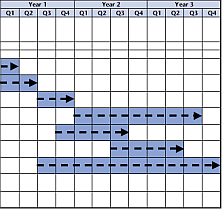Project Planning Checklist

1. Define The Initiative
The first thing you should do to set up a new project is to outline a “roadmap” which will be a reference point for your future project. Follow these guidelines:
- Define goals of your project and the final outcome you want to obtain.
- Set deadlines for the goals. Be pragmatic.
- Assemble a team by selecting a group of people who will assist you in achieving the goals.
- Define supplies and resources required to successful accomplishment of the goals.
- Choose project management software to manage the planning process.
These tips are basic and designed to give you a common understanding of the project planning process and what it will require of you to initiate a project. Using this information now you can try to break the “big picture” idea of the process into smaller components, including Goals, Deadlines, Team & Resources, and then start your project.
2. Organize Project Paperwork
The way how well you organize paperwork required for project planning activities will define your ability to handle challenges, refine necessary information, and address project planning issues. The following steps should be considered to make your project’s paperwork organized:
Keep a Diary
You should keep a diary to record there all your project planning steps and rehash daily events. Don’t put your project diary aside. It takes about thirty minutes a day to make a note but the diary helps put everything into perspective and organize your thoughts into a coherent narrative. You can keep a history of project planning events (something like “event log”), so if an issue arises later you can successfully settle it rather than trying to remember.
Centralize Documentation
Keep all project planning papers together in one place as this will help you find any necessary document quickly and audit all documentation much easier. Whether you run a small or large project, all work papers should be centralized and located in one place. You can use document management software to organize paperwork.
Label Folders and Files
Labelling or marking of folders & files will help you remember to put documents back where they should be, and make it easier for the team to find required papers in a shorter time period. Consider using binder clips and note cards to identify the contents of a folder or file.
Keep Active Documents Close at Hand
Those papers used most of all, day by day and hour by hour should be close at your hand. You need to keep your paperwork under control in order to focus on project planning tasks.
Make a New Start
When you need to start a new project while current project is still in progress, first you must close all pending and incomplete tasks. Multitasking has never been a good practice. Meanwhile, you can try to run several parallel projects, but first be sure you’re able to do so, your team supports your effort, and you have a powerful document management system for managing paperwork and docs.
3. Project Plan Implementation
As you know, a journey of a thousand miles begins with a single step. This saying is quite applicable to implementation of your project plan and related activities. Once the goals are defined, deadlines are set, the team is assembled and necessary supplies are obtained, it is time to put your project plan template into action. The way or order of your steps to implement the project planning initiative can vary as various methods and techniques of project management offer various action lists. However, a set of common recommendations that help you implement the plan include:
- Check if all activities and tasks to deliver the goals are included in your plan.
- Create a schedule where you list project planning tasks, to-do items and jobs assigned to team members. Use schedule tracking software to review and control working hours of the team.
- Have a meeting with your team to brainstorm project planning ideas and discuss outstanding issues.
- Check if all necessary project planning tools and documents are provided.
You shouldn’t spend too much time thinking about exactly which project planning step or action to take first. Just remember – any move forward is a good move. Even if you feel stuck at the beginning of your project, don’t stop moving forward as just getting started will give you the momentum that helps keep you going to the right direction.
4. Keep Track of Progress
If you have ever done a long journey, then you know any long journey is a combination of smaller trips and stops to see or visit an interesting place. This is how your project plan will work. Regardless of size and duration, your project is just a series of smaller tasks and actions to do. Your job is simply to track current status of the tasks. Here’s what you need to do when tracking progress of your project management plan:
- First of all, create a list of milestones where each milestone is a scheduled action to track current status of the planning process. You will use this list throughout the whole project.
- As each milestone gets you closer to the end of the project, you should focus on one milestone at a moment. Focusing will let you review only ongoing tasks and solve current problems.
- Move to a new task only after completion of the previous one, and then you will systematically pave your way to the project’s end. Avoid multitasking!
- Make pauses and track tasks trying to review how project planning deadlines are being met and whether you’re on the right way to get the expected deliverables.
You should recognize that throughout your project’s life-cycle you may feel that the project is lot less overwhelming and complicated. Don’t pay too much attention to the whole progress but use a step-by-step tracking method to complete current tasks and contribute to overall work progress.
5. Finalization
This is the last step in the project planning process. It’s like the last stop in your long journey. You should check deadlines to check ша you keep to the schedule and whether you’re getting what you want. Here are several actions do to finalize your project:
- Arrange a post-implementation review meeting to summarize the work done. This meeting is very important as you can determine what was wrong and debrief the team.
- Make a list of unfinished tasks and find ways to complete them as soon as possible.
- Compare actual results with expected ones. Have you met your goals? Have you applied all the resources and supplies to achieving better results? Have you met deadlines?
- Use project planning software to create a report and share it with all the people concerned. The report can formally state about the closure.
- On the last meeting you can express personal thanks to all contributors and team members.














